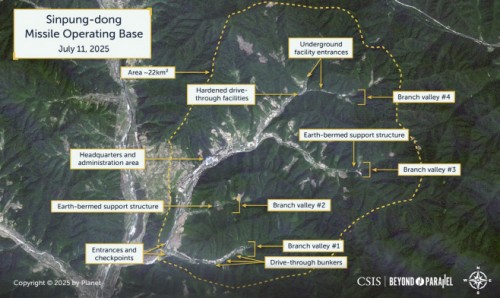 |
| A military base near Sinpung-dong, North Pyongan Province, suspected of storing ICBMs, captured by U.S. satellite firm Planet Labs on July 11. / Source: CSIS via WSJ |
North Korea has built a secret military base near the Chinese border to store intercontinental ballistic missiles (ICBMs) capable of striking the U.S. mainland, the Wall Street Journal (WSJ) reported on August 20, citing a study by the Center for Strategic and International Studies (CSIS).
According to the report, the fortified underground site is located near Sinpung-dong in North Pyongan Province, about 27 kilometers from the Chinese border. Analysts believe the facility is designed to house large truck-mounted, solid-fuel ICBMs, which are harder to detect and destroy before launch.
The base is said to be comparable in size to New York’s John F. Kennedy International Airport and could hold six to nine advanced ICBMs, along with launch vehicles and several thousand troops. Missiles are likely stored without warheads to minimize risk from attacks, with nuclear warheads mounted at off-site locations within 30 minutes’ reach.
“This is not good news,” said Victor Cha, CSIS senior vice president and Korea Chair. “North Korea doesn’t need much time to launch, which makes it difficult to strike them preemptively.”
North Korea has conducted six nuclear tests between 2006 and 2017, and the Stockholm International Peace Research Institute (SIPRI) estimates the regime holds about 50 nuclear warheads and enough fissile material for as many as 40 more.
WSJ noted that North Korea intensified its underground missile base construction after the U.S. struck three key Iranian nuclear facilities on June 22. CSIS said construction of the Sinpung-dong base began around 2004, became operational a decade later, and continues to undergo fortification.
Sinpung-dong is one of 15–20 undeclared North Korean missile sites, nine of which CSIS has publicly reported on. Jennifer Jun, co-author of the study, said the regime went to great lengths to conceal the facility: “Sinpung-dong was by far the hardest site to identify.”
While Pyongyang concentrates short-range weapons near the inter-Korean border and within striking distance of Japan, it often stations ICBMs in the northwest near China. Cha said the site’s location was intentional: “By placing it near the Chinese border, North Korea makes it harder for the U.S. to even consider preemptive strikes.”
Most Read
-
1
-
2
-
3
-
4
-
5
-
6
-
7





















